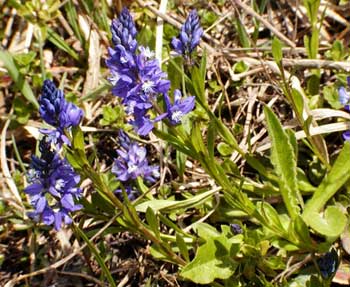Contents:
Common Names | Parts Usually Used | Plant(s) & Culture | Where Found | Medicinal Properties
Uses | Formulas or Dosages | Bibliography
Scientific Names

- Polygala amara L.
- Polygalaceae
- Milkwort family
Common Names
- Dwarf milkwort
- European bitter polygala
- European senega snakeroot
- Evergreen snakeroot
- Flowering wintergreen
- Fringed polygala
- Little pollom
Parts Usually Used
The entire plant
Back to Top
Description of Plant(s) and Culture
Bitter milkwort is a European perennial plant; the usually simple stem, only 4-6 inches high, rises from a rosette of obovate basal leaves and itself bears alternate, oblong-ovate leaves. Terminal racemes of blue, sometimes rose-colored or white, flowers appear from April to June.
Other varieties: P. vulgaris; P. senega; P. sibirica (Siberian milkwort); P. reinii (Chinese milkwort).
Back to Top
Where Found
Grows in the dry parts of wet meadows and in sunny, rocky places, preferring limestone soils.
Back to Top
Medicinal Properties
Bitter tonic, diaphoretic, expectorant, galactagogue
Back to Top
Uses
Commonly used for coughs, chronic bronchitis, and other chronic lung problems, arouse a sluggish appetite. Extended use of the rootstock is useful in relieving chronic diarrhea. Nursing mothers may increase milk flow using bitter milkwort.
Back to Top
Formulas or Dosages
The best plants grow in dry areas.
Infusion: use 1 tsp. of the plant with 1 cup boiling water. Take 1 cup a day.
Decoction: use 4 tbsp. leaves with 3/4 cup water. Boil for an extended time. Take 1 tbsp. every 3 hours.
Powder: take 1/4 to 1/2 tsp. at a time.
Back to Top
Bibliography
![]() Eastern/Central Medicinal Plants
Eastern/Central Medicinal Plants, by Steven Foster and James A. Duke., Houghton Mifflin Company, 215 Park Avenue South, New York, NY 10000
![]() Chinese Medicinal Herbs
Chinese Medicinal Herbs, compiled by Shih-Chen Li, Georgetown Press, San Francisco, California, 1973.
![]() The Herb Book
The Herb Book, by John Lust, Bantam Books, 666 Fifth Avenue, New York, NY. copyright 1974.
![]() Indian Herbalogy of North America
Indian Herbalogy of North America, by Alma R. Hutchens, Shambala Publications, Inc., Horticultural Hall, 300 Massachusetts Avenue, Boston, Massachusetts 02115, 1973
![]() Webster’s New World Dictionary
Webster’s New World Dictionary, Third College Edition, Victoria Neufeldt, Editor in Chief, New World Dictionaries: A Division of Simon & Schuster, Inc., 15 Columbus Circle, New York, NY 10023
